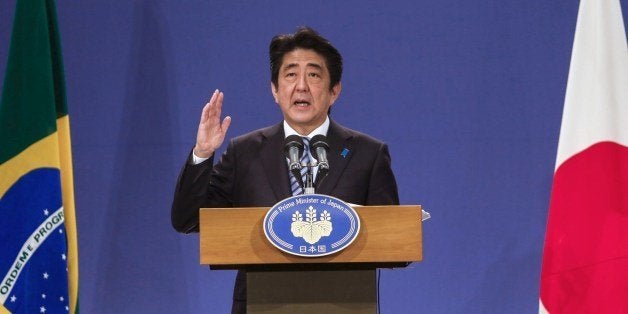
For all Japanese Prime Minister Shinzo Abe's energy, he needs to think deeper and work harder still. Japan's economy requires radical and fundamental reform. Yet much of what Abe has done so far is pretty conventional. His one venture into needed basics can only be described as weak. Unless he steps up his game, Japan will remain mired in the stagnation that has plagued it for more than 20 years now.
Abenomics, as he calls his policies, contains three elements, or "arrows" in his terminology. One is a huge program of infrastructure spending. The second is a massive infusion of liquidity into the country's capital markets. Though much fanfare surrounded the introduction of these measures, they are substantively like may other efforts that have failed Japan regularly during the past two-plus decades. The prime minister's third arrow, loosed only recently under the heading "Strategy for Reviving Japan," acknowledges for the first time the economy's urgent need for basic reform, but it hardly even begins to address Japan's overpowering problems.
Demographics lie at the heart of Japan's troubles. According to the government in Tokyo, increased life expectancies and very low birth rates have combined to raise the proportions of elderly in the population to unprecedented levels. Today, over a fifth of Japan's people are over 65. The country has fewer than three people of working age available to support each retiree. By 2030, it will have less than two people of working age for each retiree. If left unaddressed, such a lopsided mix of producers and consumers will bankrupt Japan's pension system and assure a stunted pace of growth.
Such imperatives make what Abe has proposed look more like a gesture than a policy. He would supplement Japan's supply of labor in part by bringing small numbers of workers in from abroad, those with needed skills, "trainees" his strategy document calls them. But the number he quotes constitutes little more than a rounding error in Japan's demographic trends. Even if he were willing to go further, Japan's notoriously xenophobic culture raises questions about how much help immigration can ultimately offer. Another Abe proposal is equally inadequate. He plans to exempt higher paid "white collar" workers from over-time rules. Squeezing more hours out of existing workers would fill some of the gap left by a shortage of working-age people, hardly enough, however, to cope with Japan's reality.
Abe's plan to bring more women into the workforce offers theoretical promise. According to Japan's government's statistics bureau, less than 50 percent of working-age women in Japan are employed outside the home. (The figure in the United States, according to the Labor Department, is about to 70 percent.) But it is hard to see how Abe's plans would move many women to change their ways. He would encourage mothers to return to the workforce by creating after-school programs for 10,000 children and increase the number of day-care centers. Ten thousand children is a lot, but even in a country with remarkably low birth rates, it is only a beginning. Abe would also modify tax and pension rules that presently favor stay-at-home moms. He would get a stronger response if he also changed Japan's labor laws so that women could command equal pay to men and if workplace rules were made flexible enough to allow release time for them to ferry children from school to other supervised activities. Abe mentions neither option.
Nor do the proposals even touch on the potential from encouraging longer careers for older workers. Such an effort would help in two ways, by increasing the number of people available for work and by reducing the proportion of dependent retirees in the population. Yet the Japanese, who are the longest lived people on earth, continue to support the youngest average retirement age, only 60 years. Surely a change in pension law and more flexible workplace rules that allow elders part-time status could add ten or more years to the average career.
Prime Minister Abe has also failed to take steps that might find relief in a re-orientation of Japan's economy. The country might well abandon its heavy reliance on exports as a growth engine and turn instead to consumer spending as an economic driver. Its relative shortage of workers and superabundance of retirees would certainly favor such an approach. As part of such an adjustment, Japan could relieve its demographic strains still further by relinquishing to China and other emerging economies the production of simpler goods, those with processes that require a lot of labor, and better use its limited but highly trained workforce by re-focusing domestic production on more complex, high-value-added processes and products.
Such moves would produce an emphasis on innovation, training, and capital spending that would answer another needed fundamental reform. Japan has to abandon its top-down approach to economic management. For decades, the economy has taken its lead from what the Japanese call the "iron triangle" -- a close cooperation between politicians, bureaucrats, and big business. The arrangement once worked well, marshaling Japan's economic resources for clear goals based on developments in the United States and other more developed nations of the time. But Japan caught up with the West some 30 years ago. Growth opportunities now need a more innovative economic culture, one that encourages business and technological experiments in hundreds, thousands of smaller firms. The triangle has resisted such a move, for it would naturally challenge existing business hierarchies. Abe has made no proposal to address this matter either.
Perhaps it is too soon to dismiss the prime minister and his program. Perhaps Abe recognizes the need for still more fundamental reform. There is always hope. Until, however, he does commit himself and his country to a convincing and concrete policy of basic reform, it will remain impossible to generate much optimism about Japanese prospects.